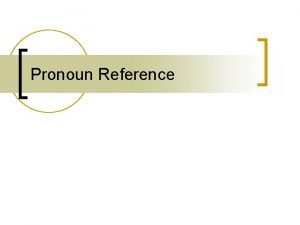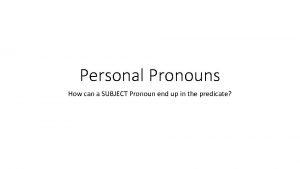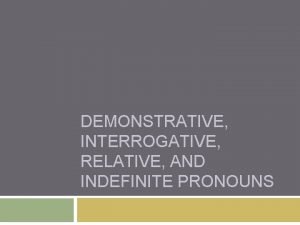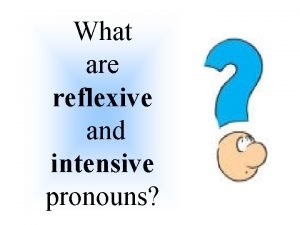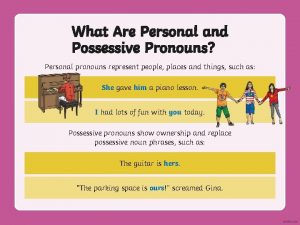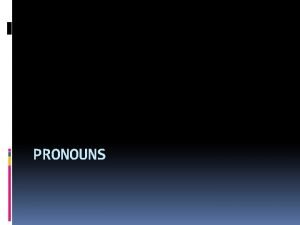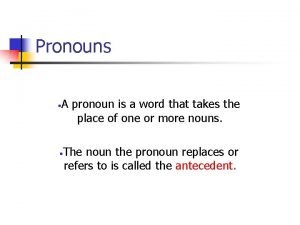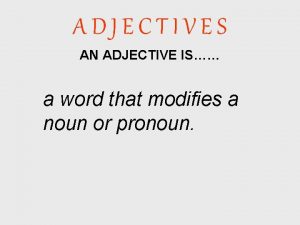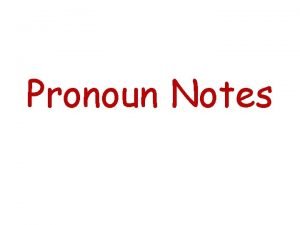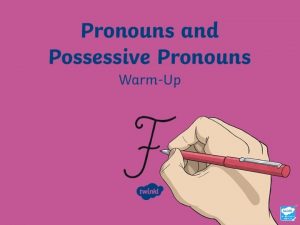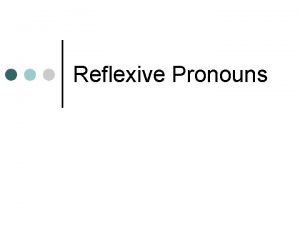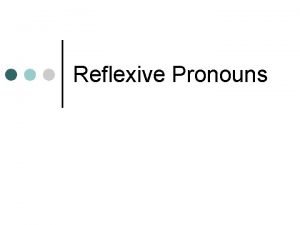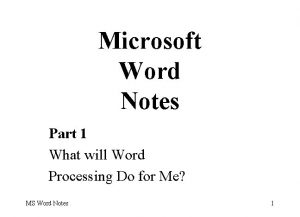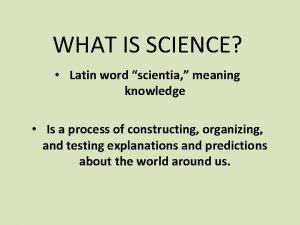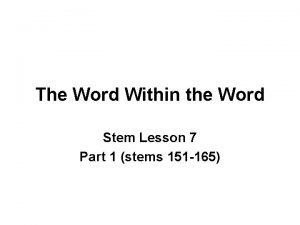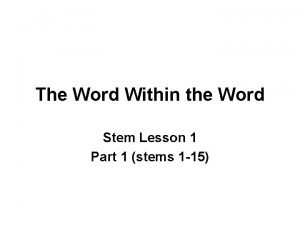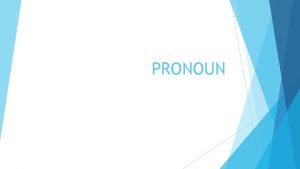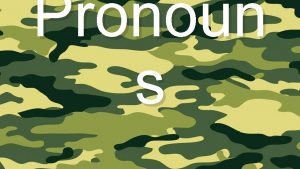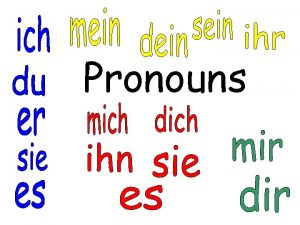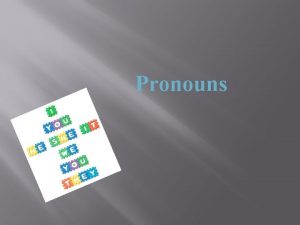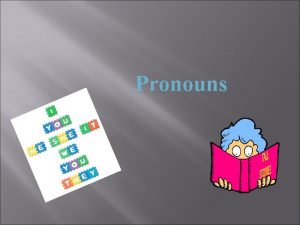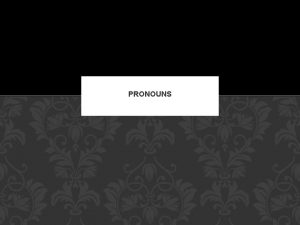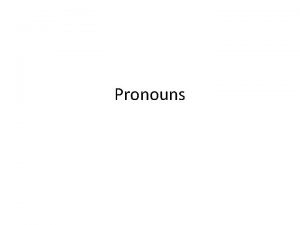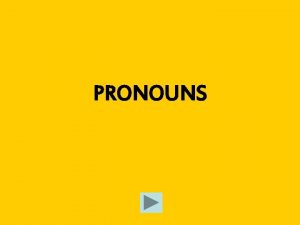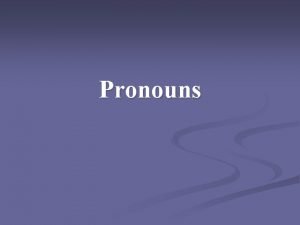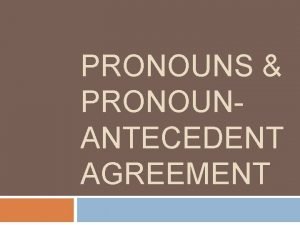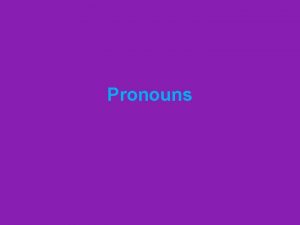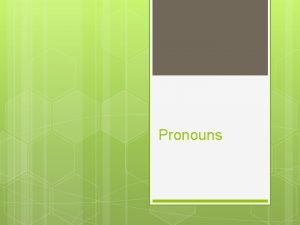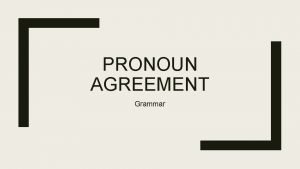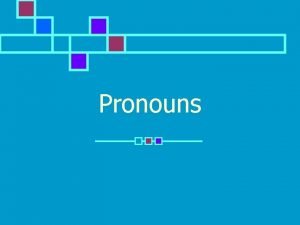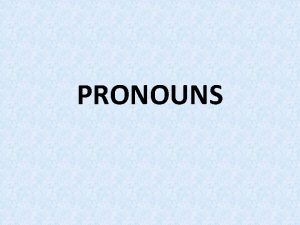Pronouns Notes Pronouns A pronoun is a word

























- Slides: 25

Pronouns Notes

Pronouns A pronoun is a word that takes the place of one or more nouns. Pro- means for (standing FOR a noun)

Personal Pronouns that are used to refer to people or things are called personal pronouns. Examples: he, she, it

Subject Pronouns A subject pronoun is used as the subject of a sentence. The subject is WHO or WHAT the sentence is about. She is my sister. It is my hat. Does he have a dog. You and I go to the movie.

Object Pronouns An object pronoun is a personal pronoun in the objective case. It is used as the direct or inderect object of a verb. Object pronouns will never be the subject of the sentence. Give the pencil to me. The teacher gave her a referral. I will tell you a secret. Hannah read it to them.

List of Personal Pronouns Singular Plural Subject Pronouns I you he, she, it we you they Object Pronouns me you him, her, it us you them

Your turn 1. Listen to this song and then lets try it together! http: //www. youtube. com/watch? v=S Wnc 1 HSCv. RY 2. Activity. Identify the pronouns in the following sentences. Jamie and Clara loved the guinea pig their mother bought them. It was white, and it was adorable.

Using Pronouns Correctly How do you know when to use me or I, we or us? 1. Use a subject pronoun as a subject. 2. Use an object pronoun as object of the verb. Examples (Circle the correct pronoun listed): SUBJECTShe owns a collection of books. INDIRECT OBJECTHe told her an amusing story. DIRECT OBJECTThe fable entertained us.

Using Pronouns Correctly When in a pair (Susan and I) Always take the pronoun OUT of the pair to see which pronoun is the correct one to use. EXAMPLES: Richard and (I or me) recited the story. Jennifer helped Richard and (I or me). Read sentence without the words that the pronoun is paired with to see what works.

Using Pronouns Correctly When using a pronoun in a pair: **ALWAYS put the pronoun second Seth and I read some comic books. (Not I and Seth) Science interests Mike and me. (Not me and Mike).

Using Pronouns Correctly In formal writing and speech: use a subject pronoun after a linking verb. RIGHT The winner is she. NOT She is the winner.

ACTIVITY 2 Replace one of the nouns in the following sentences with a pronoun. 1. Tanner and Tanner’s friend Todd won the boat race. 2. Why did Oscar give Oscar’s camera to the school? 3. Darius scored a goal; the first of Darius’ season.

PRONOUNS AND ANTECEDENTS Antecedent. The noun or group of words that a pronoun refers to Example: Tyler read “The Hungry Caterpillar. ” He found it exciting. ANTECEDENT of he __________ ANTECEDENT of it _________

PRONOUNS AND ANTECEDENTS RULE FOR PRONOUNS and ANTECEDENTS: 1. 2. Pronoun must agree with antecedent in number (singular or plural) and gender. The gender of a noun may be masculine (male), feminine (female), or neuter (referring to things).

ACTIVITY 3 Complete p. 379 Exercise 5.

Possessive Pronouns Possessive Pronoun A pronoun that shows who or what has something. NOTE: A possessive pronoun may take the place of a possessive noun.

Possessive Pronouns Examples: Matt’s shoe is too small. Replace noun with possessive pronoun. _______ shoe is too small. Mike’s homework is perfect. Possesive Noun- _____ Replace with pronoun- _____ homework is perfect.

Possessive Pronouns Possessive pronouns have two forms. - One form is used before a noun. - The other form is used alone. Used before nouns Used alone Singular Plural my your his, her, its mine yours his, hers, its our your their ours yours theirs

Possessive Pronouns ALWAYS REMEMBER: POSSESSIVE PRONOUNS do NOT contain an apostrophe. * Possessive its never splits. *It’s - is a contraction standing for it is *Its no apostrophe is POSSESSIVE Example: I love my book. (Its) characters are funny. *“Its” is a possessive pronoun standing for what noun?

Activity 4 Complete p. 703 Exercise 4 to review possessive pronouns.

Indefinite Pronouns Indefinite pronoun A pronoun that does not refer to a particular person, place, or thing. Example: Does anyone know where Mr. Malloy went? Everyone thought he was hiding in a locker. NOTE: Most indefinite pronouns are either ALWAYS singular or plural.

Some Indefinite Pronouns Singular another anybody anyone anything each either everybody everyone everything much neither nobody Plural no one nothing one somebody someone something both few many others several SINGULAR or PLURAL All, any, most, none and some can be singular or plural, depending on the phrase that follows them.

Indefinite Pronouns When an indefinite pronoun is used as the subject, the verb must agree with it in number. EXAMPLE: Everyone discusses the dance last Friday. (singular) Both talk about how fun it was! (plural) All of the dance was very loud. (singular) All of the middle school kids were dancing fools. (plural)

Some Indefinite Pronouns Possessive pronouns often have indefinite pronouns as their antecedents. In such cases, the pronouns must agree in number. Each of the teachers has his or her unique teaching style. Several have funny conversations with their students.

Activity 5 Find the indefinite pronouns in the following sentences. All of the students in this class are adorable. Each one of them make me very glad. Some of them are talkative, but most of them are very well-behaved. Which is something for which all teachers are grateful.
 Object personal pronouns
Object personal pronouns Meaning of objective pronoun
Meaning of objective pronoun Possessive adjectives interrogative
Possessive adjectives interrogative Personal pronouns complement
Personal pronouns complement Interrogative pronouns german
Interrogative pronouns german What is an intensive pronoun
What is an intensive pronoun Personal pronouns possessive pronouns
Personal pronouns possessive pronouns Conversion notes brutes en notes standard wisc 5
Conversion notes brutes en notes standard wisc 5 Is a a pronoun
Is a a pronoun First person second person third person chart
First person second person third person chart An adjective modifies:
An adjective modifies: Whats a pronoun example
Whats a pronoun example Whats a demonstrative pronoun
Whats a demonstrative pronoun Possessive and personal pronouns
Possessive and personal pronouns Reflexive pronoun function
Reflexive pronoun function Circle the demonstrative adjectives
Circle the demonstrative adjectives Reciprocal and reflexive pronouns
Reciprocal and reflexive pronouns Reflexive pronouns
Reflexive pronouns Subject pronouns 6o ano
Subject pronouns 6o ano Word columns
Word columns Science is latin word
Science is latin word Word within the word list 7
Word within the word list 7 Word within the word stems
Word within the word stems Word within the word list 5
Word within the word list 5 The word audit has been derived from the latin word *
The word audit has been derived from the latin word * Quran word by word
Quran word by word
